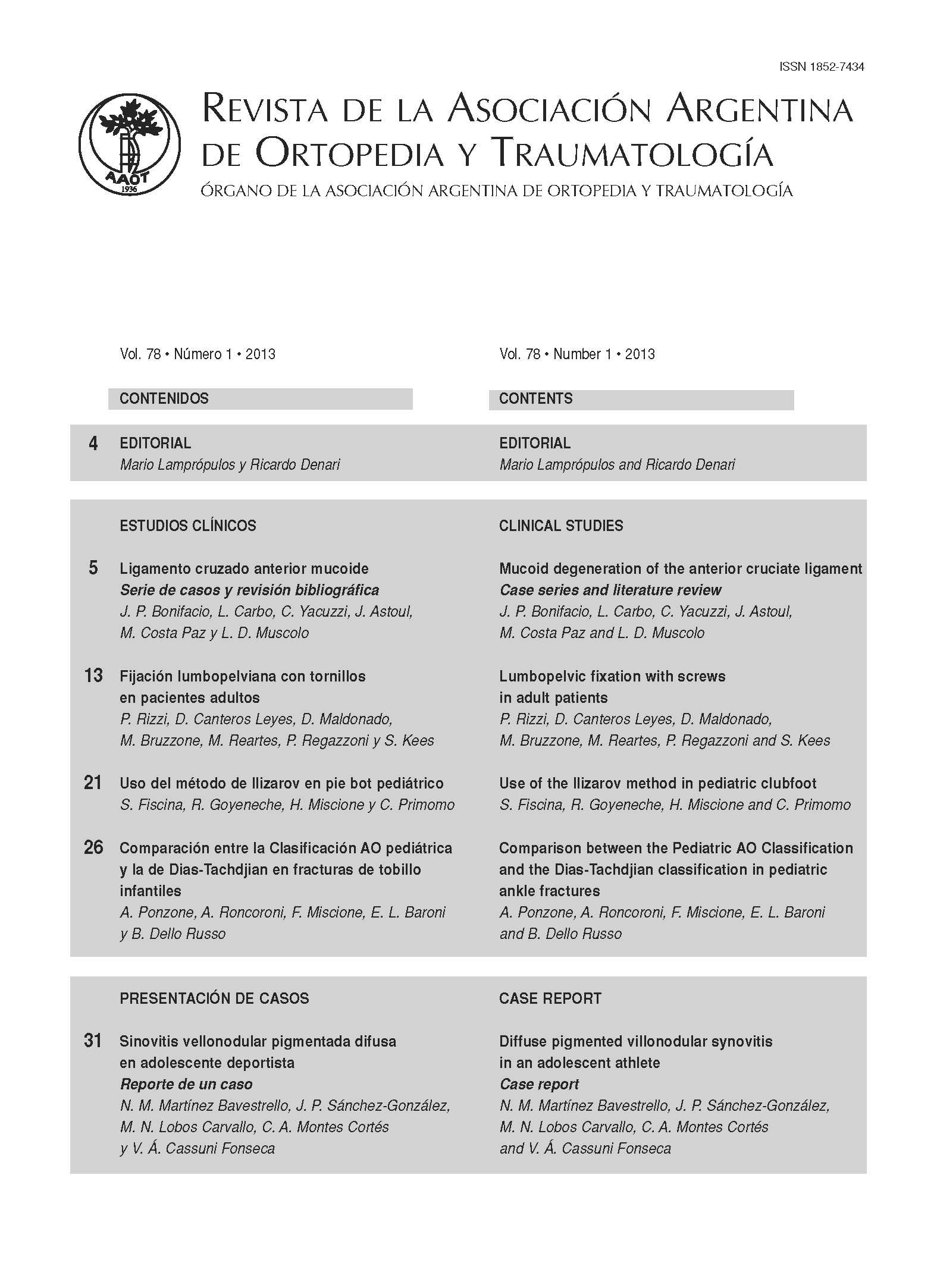Comparison between the Pediatric AO Classification and the Dias-Tachdjian Classification in Pediatric Ankle Fractures
Main Article Content
Abstract
Downloads
Metrics
Article Details

This work is licensed under a Creative Commons Attribution-NonCommercial-ShareAlike 4.0 International License.
Manuscript acceptance by the Journal implies the simultaneous non-submission to any other journal or publishing house. The RAAOT is under the Licencia Creative Commnos Atribución-NoComercial-Compartir Obras Derivadas Igual 4.0 Internacional (CC-BY-NC.SA 4.0) (http://creativecommons.org/licences/by-nc-sa/4.0/deed.es). Articles can be shared, copied, distributed, modified, altered, transformed into a derivative work, executed and publicly communicated, provided a) the authors and the original publication (Journal, Publisher and URL) are mentioned, b) they are not used for commercial purposes, c) the same terms of the license are maintained.
In the event that the manuscript is approved for its next publication, the authors retain the copyright and will assign to the journal the rights of publication, edition, reproduction, distribution, exhibition and communication at a national and international level in the different databases. data, repositories and portals.
It is hereby stated that the mentioned manuscript has not been published and that it is not being printed in any other national or foreign journal.
The authors hereby accept the necessary modifications, suggested by the reviewers, in order to adapt the manuscript to the style and publication rules of this Journal.
References
2. Slongo TF, Audigé L. Fracture and dislocation classification compendium for children: The AO Pediatric. J Orthop Trauma 2007;21(Suppl. 10):S135-60.
Marsh JL, Slongo TF, Agel J, Broderick JS, Creevey W, DeCoster TA, et al. Fracture and dislocation classification compendium - 2007: Orthopaedic Trauma Association classification, database and outcomes committee. J Orthop Trauma 2007;21(Suppl. 10):S1-133.
4. Michelson JD, Ahn U, Magid D. Economic analysis of roentgenogram use in the closed treatment of stable ankle fractures. J Trauma Inj Infect Crit Care 1995;39:1119-22.
5. Schnetzler KA, Hoernschemeyer D. The pediatric triplane ankle fracture. J Am Acad Orthop Surg 2007;15(12):738-47.
6. Harris EJ. Epiphyseal plate injuries in pediatric ankle traumatology. J Foot Surg 1981;20(3):145-7.
7. Cottalorda J, Béranger V, Louahem D, Camilleri JP, Launay F, Diméglio A, et al. Salter-Harris type III and IV medial malleolar fractures: growth arrest: is it a fate? A retrospective study of 48 cases with open reduction. J Pediatr Orthop 2008;28(6):652-5.
8. Leary JT, Handling M, Talerico M, Yong L, Bowe JA. Physeal fractures of the distal tibia. Predictive factors of premature physeal closure and growth arrest. J Pediatr Orthop 2009;29(4):356-61.
9. Cohen J. A coefficient of agreement for nominal scales. Educational and Psychological Measurement 1960;20:37-46.
10. Cerda J, Villarroel L. Evaluación de la concordancia interobservador en investigación pediátrica: Coeficiente de Kappa. Rev Chil Pediatr 2008;79(1):54-8.
11. Landis J, Koch G. The measurement of observer agreement for categorical data. Biometrics 1977;33:159-74.
12. Charlton M, Costello R, Mooney JF, Podeszwa DA. Ankle joint biomechanics following transepiphyseal screw fixation of the distal tibia. J Pediatr Orthop 2005;25:635-40.
13. De Sanctis N, Della Corte S, Pempinello C. Distal tibial and fibular epiphyseal fractures in children: prognostic criteria and long term results in 158 patients. J Pediatr Orthop 2000;9:40-4.

